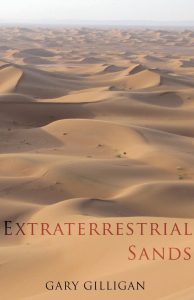Amun was the Aurora
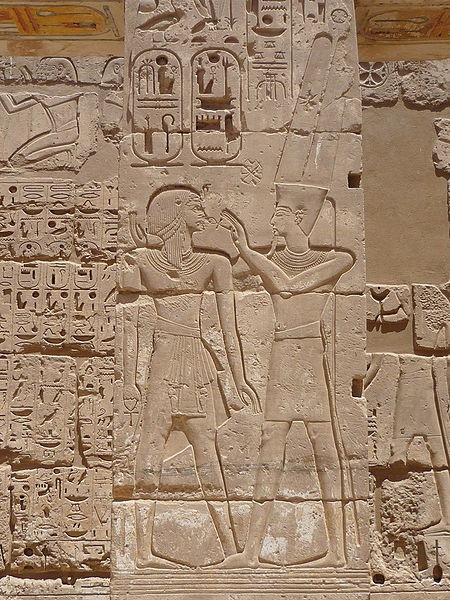
to Ramesses III (guise of Mars). Medinet Habu, Egypt. Credit: Rémih Wikimedia Commons.
Amun, the Egyptian “King of the Gods” was the Aurora
As proposed in my books and throughout my web, planetary chaos saw the plane of the ecliptic besieged with countless tons of dust, gasses and debris – this a natural consequence of any given comic catastrophe. From the perspective of earth, the ecliptic dust hazed the Sun red exactly as depicted on almost every tomb and temple wall the length and breadth of the Nile valley. A diminished red sun also allowed the Egyptian’s the luxury of wearing nothing more than a loincloth throughout the year, again exactly as portrayed (see Red Sun).
Throughout the Pharaonic period (3,000 years) tons of debris fell into the Sun’s atmosphere resulting in Coronal Mass Ejections, solar flares and prominences on a scale we would find difficult to comprehend. Courtesy of a red Sun this ‘lashing out’ was clearly observed and duly represented by the cobra which spat fire against Egypt’s foes. This being the very reason why the Egyptian Sun was many times depicted with a snake draped over it.
This ‘feeding frenzy’ dramatically increased the solar wind and gave rise to intense geomagnetic storms and global auroras unlike anything experienced in modern times. They were not restricted to the Polar Regions; they were a truly global phenomenon, observed at all latitudes especially during the night and at times, even during the day. The hazed red Sun, once again, granting visibility to the otherwise invisible.
These magical dancing neon lights were personified in the great Egyptian god Amun.
Before we proceed I would like to point out, in my latest book Comet Venus I dedicate over forty pages to physically identifying the Egyptian “king of the gods,” Amun as an auroral phenomenon. This page is to be seen as providing corroboratory support for this. Is is also presumed the reader has a basic understanding of the God King Scenario.
Amun – An Aurora Filled Sky
Amun (Amen, Amon) was the king of the gods. The name means ‘The Hidden One’.
Amun is most commonly shown entirely in human form. Often he is standing or sitting on a throne wearing a red, flat-topped crown with two tall plumes and holding a sceptre in his hand. Amun can also assume the appearance of a ram, his sacred animal. His sacred colours were blue, red, yellow and green and his images are to be found throughout the Nile Valley.

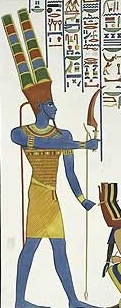
Two images of Amun sporting two tall plumes or feathers. These are very important for as I will shortly show they are actual physical representations of Auroral lights.
The enormous temple complex of Karnak was the principal home of Amun where he was worshiped as the prominent divine entity. During the New Kingdom, his popularity eclipsed that of other major deities; he was the ‘king of the gods’. The warrior-god Montu was believed to be a manifestation of Amun. A Theban triad consisted of Amun, his wife Mut, and their offspring Khonsu, the moon god. All three had temples at Karnak.
Amun is a god whose attributes are so extensive it lacks the personality of other deities. His role as creator is emphasised in many hymns. He was believed to be self-generated. As a fertility god, he impregnated his mother, the Celestial Cow, to ensure the fecundity of animals and plants. He was closely involved with kingship, and many pharaohs regarded themselves as one of his incarnations and incorporated his name into their own (Tut-ankh-amun).
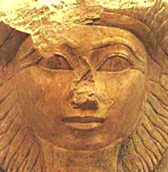
Amun was also seen as the divine consort of Egyptian queens (‘god’s wife of Amun‘). Queen Hatshepsut (right) presented herself as an offspring of the god during a visit to her mother. His virile strength made him an appropriate deity for ensuring military victory for the pharaoh. Amun was invoked for healing from the bites of dangerous animals and other illnesses. During the New Kingdom, he was a personal-saviour god of ordinary working people, as numerous devotional stele testify. Amun later became synchronised with Re to become Amun-Re.
Many catastrophist writers have attempted to give physical identity to Amun by placing him in the world of chaos. One of the most widespread identifications is the linking of Amun with Jupiter. This is because Jupiter is the largest planet in the solar system and, since Amun was referred to as the ‘king of the gods’, Amun must therefore be Jupiter. This is an unsatisfactory explanation and exhibits a lack of knowledge about the ancient world. How could ancient people possibly know that Jupiter was the largest planet? From Earth it is a mere speck of light in the night sky. It is not even the brightest ‘star’. Excluding the Sun and Moon, the brightest light in the sky is Venus – why wasn’t Venus deemed king of the gods? What of the bright star Saturn or even Mars? If Amun was Jupiter, how do we explain Amun’s tall feathery plumes, his sacred colours, his syncretism with Re (Amun-Re) and epithets such as ‘one whose true form could never be known’? How can any of these apply to Jupiter?
Egyptologists fair no better. They understand Amun’s role in connection with the monarchy, but what is the meaning behind his strange plumes and curious epithets? Their best explanation is to present him as a solar deity – once again they point to the Sun.
The key to physically identifying and understanding Amun lies with his unusual, tall plumes and the colours contained within. They were direct representations of magical celestial lights that were observed the world over in ancient times – a phenomenon we call the Aurora.
The Aurora
The auroras are the Aurora Borealis (Northern Lights) and the Aurora Australis (Southern Lights).
Auroras are striking displays of coloured lights that are often seen over the Earth’s magnetic poles. They occur when the solar wind particles are trapped by the Earth’s magnetic field so they collide with molecules of air in the upper atmosphere (ionosphere). They are a spectacular sight and take the form of rapidly shifting patches of colour and dancing columns of light of various hues. The colours observed depend on several factors such as atmospheric conditions, intensity of the solar wind, temperature and location. The Aurora is always present in almost every area of the sky, but it is usually too faint to be seen except near the North and South Poles. The main colours of the Aurora are blue, yellow, red and green, the very same colours attributed to Amun.
The intensity of the Aurora is dictated by the solar wind, a stream of electrically charged particles from the Sun. When the solar wind blows exceptionally strong, the Aurora increases. The periods of maximum and minimum intensity of the Aurora coincide almost exactly with those of the sunspot cycle, which is an 11-year cycle. When the Sun is in the active phase it can unleash powerful magnetic storms that disable satellites, threaten astronaut safety, and even disrupt communication systems on Earth.
In March 1989, the Sun unleashed a tempest that knocked out power to all of Quebec, Canada, leaving six million people without electricity. Such intense magnetic storms cause spectacular, widespread auroras, even at latitudes as low as Mexico, which is 23 degrees north (similar latitude to Egypt).
As mentioned above 3,000 years ago, at the height of planetary chaos solar activity was far more intense than anything experienced today. Cosmic catastrophe gave way to intense geomagnetic storms and global auroras – seen at all latitudes day and night. They were observed during the day courtesy of the red Sun which gave rise to a twilight world. These shimmering magical lights were personified in the great god Amun.
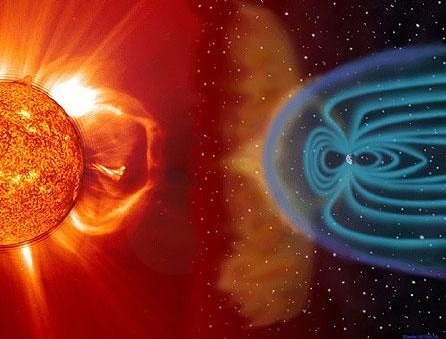
The solar wind bombarding Earth’s magnetic field causing the Aurora (below). Note the Sun’s cobra ‘lashing out.’ Such phenomenon was clearly observed 4,000 years ago as dust and debris hazed the Sun red from perspective of earth.
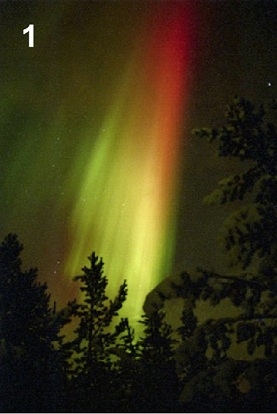
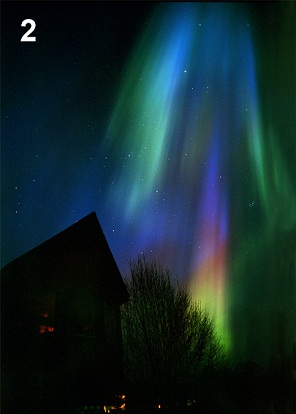
These beautiful photographs above are of the Aurora Borealis or Northern Lights. Image 1 shows the distinctive plumed-shaped aurora coloured red and green with a hint of yellow. Image 2 shows a distinctive plumed-shaped aurora with blue as the main colour supported by green, red and a hint of yellow. Similar plumed aurora are seen below next to Amun on the right.
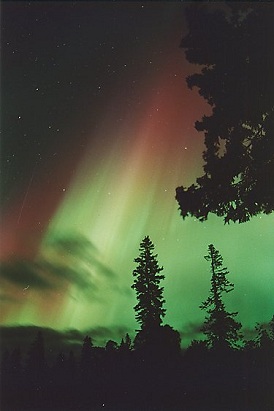
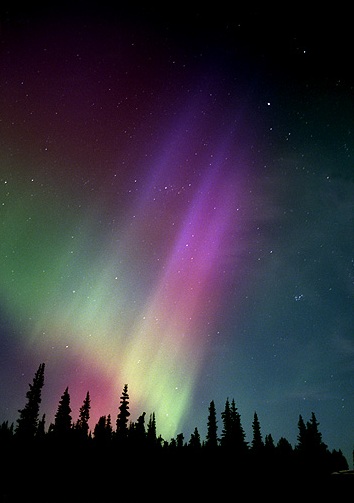
There are thousands of similar aurora photographs on the web and I have provided many links below. These include homogenous arcs, bands, active arcs, rays, pillars, plumes, draperies (or curtains) and coronas. The key point is that they all display the same basic colours attributed to Amun – blue, red, green and yellow.
We will now examine Amun and his very distinctive plumes.
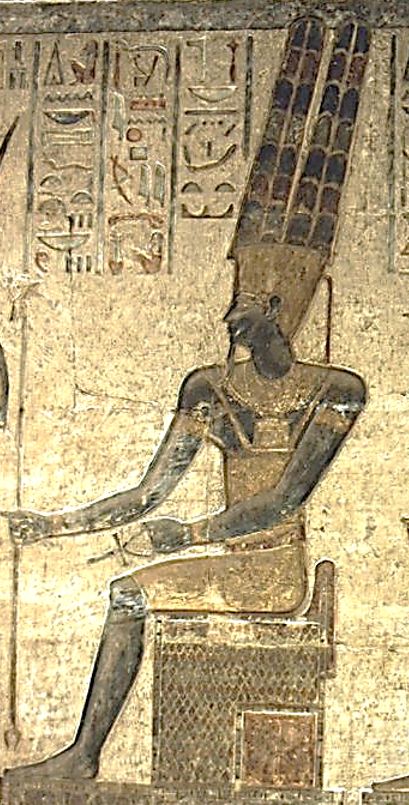
the two “Feathers Crown” inspired by the aurora.
The images above, left and below depict Amun in typical form and colours of blue skin, yellow kilt, and red flat-topped crown with tall plumes segmented into sections of green, blue and red. A thin yellow frame separates these colours. Similar images of Amun can be found above and below.
If we compare the photos of the aurora with Amun’s tall plumes, the resemblance is striking – the ancient world was dominated by geomagnetic storms and this was encapsulated in the ‘king of the gods’ Amun.
Sky watching in ancient times would have revealed Hathor (earths rings, celestial cow) arching across the heavens in all her glory. Re, the red Sun, Ptah/Jupiter, Sokar/Saturn and Isis as the main guardians of the ecliptic. While the planets Mars, Venus, Mercury and the Moon took on the role of exhalted god kings – named and renamed many times over, generation after generation as they lived and died to earth battling to maintain ‘divine order’(maat) in the process. However, outranking all of above and more, was the omnipresent Aurora as Amun. Magical, shimmering curtains of coloured neon lights danced across the celestial sphere in the guise of Amun, the ‘king of the gods’. To support this groundbreaking identification, we will examine Amun’s attributes, epithets and his close relationship with the astral monarchy.

Amun’s colours were at times interchangeable. Although his flesh was predominantly blue (his sacred colour), some images reveal a red coloured flesh. His segmented plumes were sometimes coloured yellow or white, as too was his crown. The plumes were often depicted devoid of segments, as in the photograph below, and were painted just one colour, normally yellow or white. Why was this?
There is nothing complicated here. Any variants in colour reflected the colours seen at the time which could change on a daily, weekly or monthly basis. Sometimes red covered the entire sky, other times blue, green, yellow or a combination of all colours.
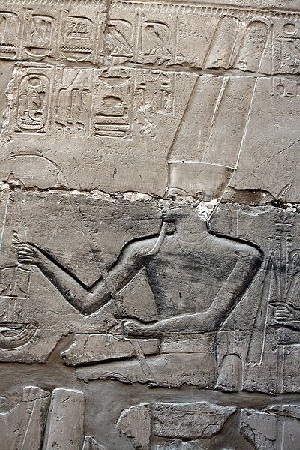
The colour of an aurora depends on the type of atom or molecule, according to Hal Kibbey of Indiana University.
“High-altitude oxygen, about 200 miles up, is the source of rare, all-red auroras, Kibbey explains. Oxygen at lower altitudes, about 60 miles up, produces a brilliant yellow-green, the brightest and most common auroral color. Ionized nitrogen molecules produce blue light, and neutral nitrogen glows red. The nitrogens create the purplish-red lower borders and rippled edges of an aurora.” (Science Astronomy).
The Egyptians merely reflected what they saw. Please note; all images of Amun were once brightly painted.
Why were there two plumes rather than one or three? The celestial gods and divine kings were, by their very location, associated with Upper and Lower Egypt (heaven and Earth), hence the title ‘lord of the two lands’. Amun’s transitional location was no different, so he too naturally adorned the title ‘lord of the two lands’. There is another possible reason for the wearing of two plumes and this has to do with dust and debris granting visibility to earth’s double plumed magnetotail, this is subject for a later date (it’s in my book though).
Tutankhamun’s (Mars) restoration stela states:
“May he (Tutankhamun) be given Life, like Re forever and ever, Beloved of Amun Lord of the Two Lands…”
What better way to represent such an exalted position than by placing two of Amun’s auroral plumes atop of his crown. Amun’s flat-topped crown is undoubtedly the crown of Lower Egypt and was adorned by the god due to his close proximity to Earth – he was closer to Earth than almost all other deities.
The name Amun means ‘the hidden one’. This ‘hidden’ aspect is further reflected in Amun’s many epithets. He was:
“The great god whose name is unknown’, ‘he, whose name is hidden’, ‘one whose true form could never be known’, ‘He, who hides his name and conceals his image, whose form was not known at the beginning’, and ‘Secret was your body among the elders, and you keep yourself hidden as Amun, at the head of the gods”. (Leiden Papyrus)
How do we explain such hidden traits? Re was the sun god – an incandescent ball of ‘fire’ (electricity!) which was an easily recognisable divine body. He illuminated the two lands with his light and was revered because of this. But who or what was responsible for the magical lights of the Aurora? What body or being triggered the transparent, ghostly manifestations? There was no heavenly body – there was an ‘effect’ but, from the Egyptian perspective, no ‘cause’. This is why Amun was known as the ‘hidden one’ and ‘one whose true form could never be known’.
This raises the question: ‘Why was Amun predominately depicted in human form if his true form was not known?’ The Greek philosopher Xenophanes stated that if horses could draw a picture of the divine, it would look like a horse. We have a similar situation here – a blank canvass. The Egyptians were able to choose how they wanted to represent the god responsible for the Aurora and they naturally chose the human form. The auroral colours were captured in his flesh, attire and crown while the Auroras main form, that of pillars, were embodied in the tall plumes. If we take a look at a few more of Amun’s epithets, it becomes apparent that they were alluding to the Aurora:

‘Mysterious of form’
‘Who raised high the sky’
‘The king of the south and of the north’
‘Prince of rays and beams of light’
‘The flame which sendeth forth rays of light with mighty
splendour’
‘Living flame who came forth from Nun’
‘King of heaven, ruler of the two lands’
‘Who makes light/gives free passage’
‘One creator who has millions of forms & transformations’
‘Secret of manifestations and sparkling of shape’
‘Marvellous god rich in forms’
‘Light was his coming into existence on the first occasion’
(Source Leiden papyrus)
Hymn to Amun
“Amun, who developed in the beginning, whose origin is unknown.
No god came into being prior to Him.
No other god was with Him who could say what He looked like.
He had no mother who created His name.
He had no father to beget Him or to sa: “This belongs to me.”
Who formed His own egg.
Power of secret birth, who created His (own) beauty.
Most Divine God, who came into being alone.
Every god came into being since He began Himself.
Every being came into being when His being began being.
There is nothing outside Him.”
(Praise of Amun in the Decree for Nesikhonsu)
“None of the gods knows His true form, His image is not unfolded in the papyrus rolls, nothing certain is testified about Him.”
Hymns to Amun, Papyrus Leiden I 350, chapter 200, lines 22- 24.
(link with more information on Amun).
In Papyrus Louvre (3292) we also read : “Hail to you, who brought himself forth as one and who created millions in their abundance.” In Papyrus Leiden (I 344), we find : “The one alone, whose body are millions” (ibid).
The Omnipresence of the Aurora.
“He, He is the God too great to have a name ! He is the inapparent and He is the very apparent. He who the intellect contemplates ! He is also the one seen by the eyes. He is the incorporeal, the multiform, better still, the omniform. Nothing exists which He is not, for everything that exist, everything is Him. From that comes that He has all names, for all things come forth from this unique father. From that comes that He has no name at all, for He is the father of all things.” (ibid)


